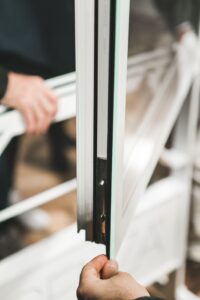The Clear Choice: Double Pane or Triple Pane Windows?
Upgrading your windows isn’t just about swapping out old glass – it’s about making your home more comfortable, efficient, and even quieter. But here’s the big question most homeowners run into: should you go with double pane or triple pane windows?
The numbers tell the story: according to the U.S. Department of Energy, heat loss and drafts through inefficient windows account for 25%–30% of residential heating and cooling energy use. Studies – including those by the Pacific Northwest National Laboratory –show upgrading to triple-pane windows improves energy efficiency by 40% or more, enhancing both comfort and energy performance. And that triple-pane windows also reduced the perceived noise level by roughly half .
It might sound like the difference is just one extra layer of glass, but that extra pane changes everything – from your heating bills to how peaceful your living room feels on a noisy street. Let’s break down what each option really means for your home so you can make a choice with confidence.
What Exactly Are Double Pane and Triple Pane Windows?
Think of them as layers of protection.Double- and triple-paned windows are built as Insulated Glass Units (IGUs), where multiple panes of glass are separated by sealed spaces filled with insulating gas. As explained on Wikipedia – Insulated Glazing, these units are commonly known as double-paned or triple-paned windows and are a major step up from old single-pane glass.
- Double Pane Windows: Two panes of glass with one gas-filled space in between. A huge upgrade from old single-pane windows.
- Triple Pane Windows: Three panes of glass with two insulating spaces. This design takes performance up a notch, adding more comfort and efficiency.
Most modern versions of both types also come with Low-E coatings – invisible metallic layers that help reflect heat. That means a warmer home in winter, a cooler one in summer, and lower energy bills year-round.
Why This Matters for You
This choice affects both comfort and your energy bills. Natural Resources Canada explains that double-pane windows already insulate well, but triple-pane windows hold in heat even better. In plain terms, triple panes keep more warmth inside during winter and more heat outside during summer, which means a cozier home and lower heating costs.
- Comfort you notice: Triple panes hold heat better, which means fewer chilly drafts near windows and steadier room temperatures.
- Lower energy bills: In Toronto winters, every bit of insulation helps. Triple panes can ease the strain on your furnace, saving you money long-term.
- Peace and quiet: That extra pane of glass also helps block street noise. If you live on a busy road, you’ll feel the difference immediately.
- Less condensation: The inner surface of a triple pane stays warmer, which means less chance of waking up to water droplets or ice inside your windows.
Double vs. Triple Pane: Side-by-Side
| Feature | Double Pane | Triple Pane |
| Energy Efficiency | Good to Excellent | Excellent to Superior |
| Upfront Cost | Lower (Standard) | 15-30% Higher |
| Soundproofing | Good | Excellent |
| Condensation Control | Good | Excellent |
| Weight | Lighter | Heavier (needs stronger frames) |
How to Choose What’s Best for Your Home
Here’s how to figure out if double or triple panes are the smarter move for you:
- Climate check: In colder Canadian climates, triple pane windows have a clear advantage. They’re designed to handle long winters.
- Budget reality: Triple panes cost more upfront. Decide whether the extra comfort and savings down the road are worth it for your household. (Tip: check if your province offers rebates on energy-efficient upgrades.)
- Your home’s needs: Live on a noisy street? Triple panes help keep things quieter. Upgrading from drafty single-pane windows? Even double panes will feel like night and day.
- Look for ENERGY STAR®: Whatever you choose, make sure the window is ENERGY STAR® certified for your region. That label guarantees you’re buying a product that meets strict efficiency standards.
Common Mistakes to Avoid
- Only looking at price: Cheaper windows might save upfront but cost you more in energy bills long-term.
- Ignoring the U-factor: This number shows how well a window resists heat loss. Lower is better, so don’t just count panes – compare performance ratings.
- Skipping insulation elsewhere: Triple panes won’t fix drafty walls or attics. Get the basics right first.
- DIY shortcuts on installation: Even the best windows fail if they’re poorly installed. Always hire a certified installer.
The Ongoing Debate
Some homeowners argue triple panes only make sense in extremely cold regions like the Prairies, where energy savings quickly pay for the upgrade. Others say that even in Southern Ontario, the added comfort – no cold spots, less noise, fewer drafts – makes them worth it, even if the payback period takes longer.
There’s no single right answer here. It really comes down to your climate, your budget, and what you value more: upfront savings or maximum comfort.
FAQ: Homeowner Questions Answered
1. How do I know if triple pane windows are worth the extra cost for my home?
Start with your climate and comfort priorities. In cold Canadian winters, triple panes reduce drafts, condensation, and heating costs noticeably. If you live on a noisy street or plan to stay in your home long term, the added comfort and energy savings often outweigh the higher upfront price. But if you’re in a milder climate or thinking of moving in a few years, high-quality double panes may be the smarter balance.
2. Will I actually notice a difference in comfort between double and triple panes?
Yes – especially in winter. Triple panes keep the inside glass surface warmer, which means no more cold spots when you sit near a window. They also block more outside noise and cut down on condensation. With double panes, you’ll still see a huge improvement over old single-pane windows, but the “luxury” feel of consistent warmth and quiet is where triple panes really shine.
3. How much money can I realistically save on energy bills with triple panes?
It depends on your home’s insulation and your local energy rates. Studies show triple panes can boost efficiency by 40% compared to standard double panes, but the actual savings vary. In harsher climates, the payback is faster. In moderate areas, the dollar savings are smaller, but you’re still investing in long-term comfort and higher resale value.
4. What should I look at beyond just “double vs. triple” when comparing windows?
Don’t just count panes – check performance ratings. Look for the U-factor (lower means better insulation) and the ENERGY STAR® certification for your climate zone. Also, pay attention to the quality of the frame and installation. A poorly installed triple pane can underperform compared to a well-installed double pane.
Final Thought
Choosing between double pane and triple pane windows isn’t just about glass – it’s about how you want your home to feel. Double panes are a reliable, budget-friendly upgrade that will immediately boost comfort. Triple panes, on the other hand, are the premium choice: warmer, quieter, and more efficient for the long haul.
Either way, upgrading your windows is one of the smartest home improvements you can make – an investment in comfort, savings, and peace of mind for years to come.

